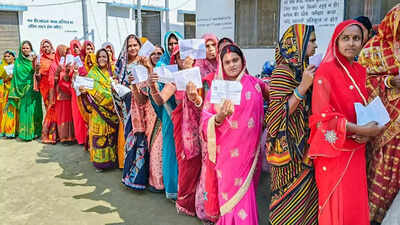As the dust settles on voting across Bihar, the sharp rise in turnout particularly the surge in women voters has become the biggest talking point of this election.Pundits and political parties alike are trying to decode which side this ‘silent but decisive’ electorate is leaning.The broad consensus emerging from ground reports and exit polls suggests that the Nitish Kumar-led NDA could be the biggest beneficiary of the record participation by women. Almost all major exit polls have predicted the NDA’s return to power, and the alliance claims the results will surpass those forecasts, citing Chief Minister Nitish Kumar’s enduring popularity among women voters.
The Opposition, however, insists that the higher turnout signals a vote for change. The truth will only be known on November 14, when votes are counted.
Highest voting in 73 years
Bihar has witnessed its highest voter turnout in 73 years. According to Election Commission data after the second phase, the combined turnout across the two phases stood at 66.91%, a massive 9.62% increase over the 2020 Assembly election.The Election Commission has clarified that the figures are provisional and will rise slightly once postal ballots and service votes are added.
Women outvoted men on 56 seats in phase 1
In the first phase, polling was held in 121 constituencies across 18 districts, registering 65.08% turnout. Women voted in significantly larger numbers— 69.04% compared to 61.56% among men— a gap of 7.5 percentage.Of the 121 seats, 56 constituencies saw women’s turnout surpass men’s. In several constituencies— including Singheshwar (Madhepura), Kusheshwarsthan, Gaura Bauram and Alinagar (Darbhanga), Bhore and Hathua (Gopalganj), and Alauli (Khagaria)— the gap exceeded 8 percent.
Phase 2: 10% Higher turnout among women
While seat-wise gender data for the second phase is yet to be released, overall trends indicate that 74.03% women voted, compared to 64.1% men — almost a 10 percent gap.Taken together, 25.17 million women voted across the two phases, outnumbering male voters (24.73 million) by about 440,000. This effectively means that each constituency saw, on an average, around 1,800 more women than men turning up at the booths.
Nitish still commands women’s trust
Early in the campaign, there were murmurs about Nitish Kumar’s health and speculation if he would remain the centre of Bihar’s politics. But as the campaign intensified, both allies and opponents appeared to concede that he remains the pivotal figure in the state’s political landscape.Even the BJP, which initially kept its options open regarding CM candidature, quickly realigned its messaging mid-campaign— asserting that it is fighting the election under Nitish’s leadership and that there was ‘no vacancy’ for the chief minister’s post.Nitish Kumar’s day-long roadshow on October 31st – amid heavy rains – put all speculation about his health to rest. Nitish stepped out for this road show despite his helicopter being grounded due to bad weather. That sent a strong message of resilience, spurring the ruling alliance to go on the offensive versus Opposition’s claims of Nitih’s fading relevance.Ground reports indicate that a substantial section of women, particularly in rural and semi-urban areas, continue to trust Nitish Kumar. While a section of Muslim women expressed some reservations, a larger share of women voters appeared reassured by the NDA’s promise of continuity of schemes, stability, and safety.
Record turnout: A sign of consolidation or change?
The historic turnout may suggest that the NDA’s core voters, specially women, turned out in full strength— possibly neutralising the Opposition’s call for change.But Bihar’s electorate has a history of springing silent surprises. Whether the exit polls have accurately captured the mood, or whether the state’s famously quiet voters have once again scripted a twist, will become clear only when the votes are counted on November 14. Go to Source


